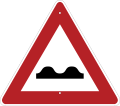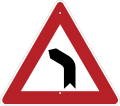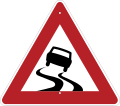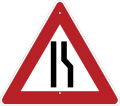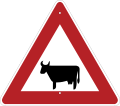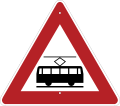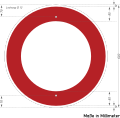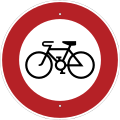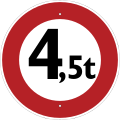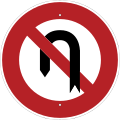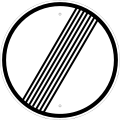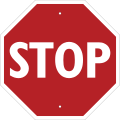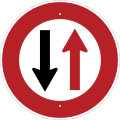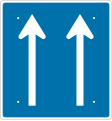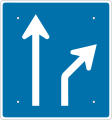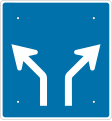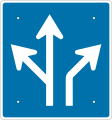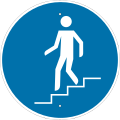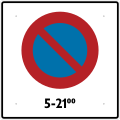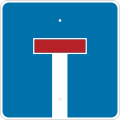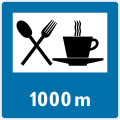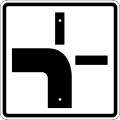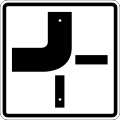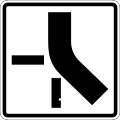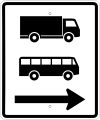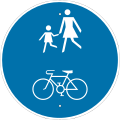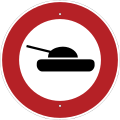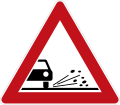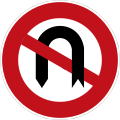
Place-name sign (back) from the revised TGL 12096/01, which became binding in 1979 (photo from 1988)

Until the fall of the Berlin Wall, the signs on motorways that became valid with the 1971 amendment to the Road Traffic Act remained largely intact and were not replaced from 1979 (photo from 1990)

The photo shows the slightly modified parking lot sign Figure 250 V 3 published in 1988 with the revised TGL 12096/01, a P + R additional sign that does not meet the TGL specifications from 1988 (Figure 423), additional signs Figure 419 and Figure 332 (photo by 1988)
The picture table of the traffic signs in the German Democratic Republic from 1979 to 1990 shows the traffic signs in the German Democratic Republic (GDR) as they were after the TGL 12096/01 came into force on May 1, 1979 until the reunification . With the Unification Treaty of August 31, 1990, the GDR was dissolved as a state structure. As stipulated in the contract, the legal norms of the Federal Republic of Germany (FRG) became effective immediately and as far as possible . This also applied to the road traffic regulations (StVO) of the GDR. Some of the stipulations important for the GDR StVO, such as TGL 12096/05 for delineator posts , had already been repealed on February 1, 1990. Only a few StVO paragraphs of the German Democratic Republic remained temporarily in force. Initially, all traffic signs lost their validity with the following exceptions: Fig. 215 (no U-turn), Fig. 419 (not valid for the type of vehicle shown), Fig. 421 (not valid for severely disabled people with special permission) and Fig. 422 (valid in wet conditions). By December 31, 1990, these characters were also invalid.
The new road traffic regulations (StVO) introduced in the GDR under the catchy name StVO 77 had some initial difficulties, as the standardization of traffic signs for industry was only published in November 1978 and became binding on May 1, 1979. The legal text of the StVO, valid since January 1st, 1978, replaced the road traffic regulations valid in the GDR since 1964. Due to the delay in issuing the TGL 12096/01, it was not possible to manufacture signs according to the new StVO until the end of 1978 at the earliest.
In addition, road traffic-relevant signs or signals of the ordinances on the construction and operation of trams (BOStrab) are reproduced in this table .
colour
TGL specifications
Since the late 1920s, the yellow-black signage for towns and country roads had manifested itself in many parts of Germany and for the first time received a nationwide standardization and validity with the road traffic regulations of 1934 . Due to the expansion of the motorway, which was also under construction at the time, technical regulations stipulated blue and white signs from the start. This color system remained in effect in the GDR until the fall of the Berlin Wall. According to TGL 12096/01 of November 1978, the following requirements for the surface quality of the traffic signs affixed with foil had to be met:
- white - reflective
- red - fluorescent (reflective for images 224 and 225)
- yellow - reflective (fluorescent for picture 301 and 302)
- green - fluorescent
Only the color designs with blue, black and orange should be achieved by the sign painters with color applications. But here, too, there was the possibility - if available - of using a corresponding film. Arrows, symbols and lettering were to be underlaid with retroreflective material according to the contours. The traffic sign posts were also painted in the GDR. According to TGL 12146, fluorescent daylight colors should be used for yellow and red. The posts for the signs on motorways were to be painted gray or hot-dip galvanized. According to Table 12 of TGL 12096/01 of November 1978, the following rule applied:
- The posts of the right-of-way signs in Fig. 130, 226 to 229 were to be painted alternately red and white along their entire length at a distance of 0.3 meters.
- The posts for the signs in pictures 301 to 304, 314, 315 were to be set up in yellow
- All other traffic signs were painted gray.
On January 1, 1987, with the revised regulation TGL 21196, a new color register became valid, which was revised again in June 1987. Sign painters could also fall back on the color palettes listed there.
practice
Practice deviated in many ways from the TGL specifications. Usually, due to the constraints of the shortage economy, only inferior and cheaper material could be used in the manufacture of traffic signs, posts and masts. The films in particular were not very durable, often puckered and quickly bleached. In order to prevent the permanent corrosion of the usually not hot-dip galvanized tubular steel posts, these theoretically had to be repainted regularly. Concrete posts, which are also possible, were more durable and cheaper. The rusting screws and washers that were on the front of most signs also made them unsightly. It was not uncommon for the sheet metal of the signs to continue to be painted entirely by hand, as in the past, when no foil material was available.
typography
With the entry into force of the TGL 12096/01 May 1, 1979 was also a new typeface introduced for the labeling of the traffic signs. Up to this point in time, the TGL 0-1451, which became binding on January 1, 1963, was a variant of the DIN 1451 that had been in use since the 1930s . As in many other areas of life and work in the GDR, with the progressive detachment from the known norms in parts of the population, a state-supporting identity and identification factor should become effective. As early as 1962 it was postulated:
"In dealing with the development of bourgeois German road traffic law, the underlying capitalist conditions are uncovered and the superiority of the socialist road traffic law of the GDR is proven."
- New publications: Explanation and collection of the most important legal provisions on road traffic law . In: State and Law , Register of Authors and Register of Subjects (1962), p. 191.
When looking for a completely new typeface for road traffic, those responsible had agreed on the bold style of the Gill Sans designed by the British Eric Gill between 1928 and 1930 . It is noteworthy that no font draft from the GDR itself or a friendly socialist brother country was chosen. However, the bold gill was unsuitable in individual forms for use as a commercial font in accordance with traffic signs. Therefore, it had to be revised in a number of areas in order to be suitable for the intended use.
Official handling of the new signage
The motorway signage, which was added to the road traffic regulations in 1970, remained in use until the turn of 1990, even though new signs were introduced in 1979. But since the expansion of the motorway in the GDR had no priority, only damaged signs were replaced. As a rule, photos and film recordings up to 1990 also document the symbols associated with this motorway signage from the StVO amendment that came into effect in 1971.
This development did not correspond to the other behavior of the GDR authorities. For example, the previous signs in the cities and in the countryside were quickly dismantled in many areas and replaced by the new signs, sometimes regardless of their good condition. In this renovation, the cities usually came first, followed - depending on the weighting - by the rural places and regions. The dismantling of all old signs was not yet completed in 1990.
I. Warning signs
Fig. 102
uneven road surface
Fig. 103
Intersection with a subordinate street
Fig. 106 V
dangerous curve
Fig. 107
dangerous double curve
Fig. 107 V
dangerous double curve
Fig. 112
Narrowing of the roadway on both sides
Fig. 113
One-sided narrowing of the road
Fig. 113 V
One-sided narrowing of the road
Fig. 115
Construction site
Fig. 116
Chippings, gravel
Fig. 118
Pedestrian crossing
Fig. 122
Flight operations
125
unrestricted level crossing
126
Railroad crossing with gates
Fig. 127
three-lined beacon
(right - 240 m)
Fig. 127 V 1
three-lane beacon
(left - 240 m)
Fig. 127 V 2
three-lane beacons
(left - 180 m)
Fig. 128
two-lane beacon
(left - 160 m)
Fig. 128 V 1
two-lane beacon
(right - 160 m)
Fig. 128 V 2
two-lane beacon
(right - 110 m)
Fig. 129
single lane beacon
(right - 80 m)
Fig. 129 V 1
single lane beacon
(left - 80 m)
Fig. 129 V 2
single-lane beacons
(right - 50 m)
130
Warning cross at the level crossing
Fig. 130 V 1
Warning cross at the level crossing
Fig. 130 V 2
Warning cross at the level crossing
II. Regulatory sign
Fig. 201
Traffic ban for all vehicles
Fig. 203
Driving ban for multi-lane vehicles
Fig. 204
Driving ban for single-lane vehicles
Fig. 205
Driving ban for all motor vehicles
Fig. 206
Driving ban for trucks
Fig. 207
Driving ban for tractors
Fig. 208
Driving ban for vehicles with multi-axle trailers
Fig. 209
Driving ban for cyclists
Fig. 210
Driving ban for trailer vehicles
Fig. 211
Driving ban for vehicles over a certain width
Fig. 211 V
Driving ban for vehicles over a certain width
Fig. 212
Driving ban for vehicles over a certain height
Fig. 212 V
Driving ban for vehicles over a certain height
Fig. 213
Driving ban for vehicles over a certain total mass
Fig. 213 V 1
Driving ban for vehicles over a certain total mass
Fig. 213 V 2
Driving ban for vehicles over a certain total mass
Fig. 213 V 3
Driving ban for vehicles over a certain total mass
Fig. 214
Driving ban for vehicles over a certain axle load
Fig. 214 V
Driving ban for vehicles over a certain axle load
Fig. 217
prescribed minimum distance for motor vehicles
Fig. 217 V
prescribed minimum distance for motor vehicles
Fig. 218
Maximum permitted speed
Fig. 219
Prohibition to overtake multi-lane vehicles
220
Prohibition of overtaking multi-lane vehicles with vehicles over 3.5 t gross vehicle weight
Fig. 221
End of all prohibitions for moving vehicles indicated by traffic signs
Fig. 222
End of the displayed permissible maximum speed
Picture 223
End of the overtaking ban
Picture 226
Stop - give way
Fig. 228
Stop - continue driving when prompted
Fig. 229
Waiting obligation for oncoming traffic
Fig. 230
prescribed minimum speed
Fig. 231
End of the prescribed minimum speed
Fig. 232
Snow chains mandatory
233
prescribed direction of travel
Fig. 233 V 1
prescribed direction of travel
Fig. 233 V 2
prescribed direction of travel
Fig. 234
prescribed direction of travel
234 V 1
prescribed direction of travel
Fig. 234 V 2
prescribed direction of travel
Fig. 234 V 3
prescribed direction of travel
Fig. 235
prescribed direction of travel for vehicles turning
235 V 1
prescribed direction of travel for vehicles turning
235 V 2
prescribed direction of travel for vehicles turning
Fig. 236
mandatory side for driving past
Fig. 240
Reduction in the number of lanes
Fig. 240 V 1
Reduction in the number of lanes
Fig. 240 V 2
Reduction in the number of lanes
Fig. 241
Enlargement of the number of lanes
Fig. 241 V
Increase in the number of lanes
Fig. 242
Beginning of a lane for slow-moving vehicles
Fig. 244
Rail vehicle stops
Photo 245
Pedestrian crossing
Fig. 246
Pedestrian bridge or tunnel
Fig. 246 V
Pedestrian bridge or tunnel
Fig. 247
for pedestrians: Use the opposite side of the street
Fig. 247 V
for pedestrians: Use the opposite side of the street
Fig. 250 V 1
parking space
Photo 250 V 2
parking lot
Photo 250 V 4
Parking lot unguarded
Fig. 250 V 5
Guarded parking lot
Fig. 250 V 6
Guarded parking lot
Photo 251
reserved parking area
Photo 252
Parking lot for taxi only
Fig. 252 V
Parking for taxis only
Fig. 253
Parking lot with limited parking time; Use only with parking disc
Fig. 253 V
Parking lot with limited parking time; Use only with parking disc
Fig. 254
Parking regulations across the direction of travel
Fig. 255
Parking regulations at an angle to the direction of travel
256
Parking regulations on the sidewalk
Fig. 257
Parking regulations halfway on the sidewalk
Fig. 258
Parking regulations on the sidewalk, across the direction of travel
Fig. 259
Parking regulations halfway on the sidewalk, perpendicular to the direction of travel
Fig. 260
Parking regulations on the road, parallel to the direction of travel
Fig. 261
Beginning of an area with traffic restrictions
Fig. 261 V 1
Beginning of an area with traffic restrictions
Fig. 261 V 2
Beginning of an area with traffic restrictions
Picture 262
End of an area with traffic restrictions
Fig. 262 V 1
End of an area with traffic restrictions
Fig. 262 V 2
End of an area with traffic restrictions
III. Notice signs
Picture 302
End of the main street
Fig. 305
Beginning of the Autobahn
Photo 306
End of the Autobahn
Photo 307
Signpost to the motorway
Fig. 308
Announcement of a motorway junction
Fig. 308 V 1
Announcement of a motorway junction
Fig. 308 V 2
Announcement of a motorway junction
Fig. 309
Signpost on motorways
Fig. 309 V
Signposts on motorways
Fig. 310
three-striped beacon
Fig. 311
two-lined beacon
Fig. 312
single lane beacon
Photo 313
Signposts on motorways
Fig. 313 V
Signposts on motorways
Photo 314
Beginning of the village
Fig. 314 V 1
Beginning of the village (bilingual)
Fig. 314 V 2
Beginning of the village
Fig. 314 V 3
Beginning of the village
Photo 315
End of the village
Fig. 317
Signpost (bilingual)
Fig. 318
Signposts for trunk roads
Fig. 319
Signposts for other paved roads
Fig. 319 V
Signs for other paved roads (bilingual)
Fig. 320
Signposts for unpaved roads
Fig. 321
Signpost for transit roads
Photo 322
Two-way traffic has to wait
Fig. 326
Telephone station
Fig. 327
Roadside assistance
Fig. 327 V 1
Roadside Assistance
Fig. 327 V 2
Roadside Assistance
Fig. 327 V 3
Breakdown assistance and petrol station
Fig. 328 V 1
petrol station
Fig. 328 V 4
Gas station and service area
Fig. 328 V 5
Gas station and service area
Fig. 330
Rest area or restaurant
Fig. 330
Rest area or restaurant
Fig. 330 V 3 Service
area and kiosk
Fig. 333
Information point
Fig. 334 Transporting
children (only attached to motor vehicles);
no sign of the TGL, but the StVO
Fig. 336
General maximum speeds in the GDR
Fig. 337 V 1
Signpost for diversions
Fig. 338
Signpost for diversions
Fig. 338 V 1
Signpost for diversions
Fig. 338 V 2
signs for diversions
Fig. 339
Signpost for diversions of motorway traffic
Fig. 339 V
Signs for diversions of motorway traffic
Fig. 340
Announcement of the lane change
Fig. 340 V
Announcement of the lane change
Additional characters
Photo 401
turning main road
Fig. 401 V 1
turning main road
Fig. 401 V 2
turning main road
Photo 402
turning main road
Fig. 402 V 1
turning main road
Fig. 402 V 2
turning main street
Fig. 402 V 3
turning main street
Image 404 in
front of and behind
Fig. 406 V
left, with length information
Fig. 407 V
left and right
Fig. 408 V 1
right, with length information
Fig. 408 V 3
diagonally to the right
Fig. 409
Distance in meters
Fig. 409 V 1
Distance in meters
Fig. 409 V 2
Distance in meters
Fig. 409 V 3
Distance in meters
Fig. 409 V 4
Distance in meters
Fig. 409 V 5
Distance in meters
Picture 410
Length of the scope
Figure 410 V 1
Length of the scope
Figure 410 V 2
Length of the scope
Fig. 413
Danger of snow and ice
Fig. 414
Risk of sudden fog formation
Fig. 415
Danger at the edge of the road
Fig. 416
Play
street free for residents
(with traffic signs Fig. 201)
Fig. 417
Train operation
(with traffic signs Fig. 101)
Fig. 418
only applies to the vehicle type shown
Fig. 418 V 1
only applies to the vehicle type shown
Fig. 418 V 2
only applies to the vehicle type shown
Fig. 418 V 3
only applies to the vehicle type shown
Fig. 418 V 4
only applies to the vehicle type shown
Fig. 418 V 5
only applies to the vehicle type shown
Fig. 418 V 6
only applies to the vehicle type shown
Fig. 418 V 7
only applies to the vehicle type shown
Fig. 418 V 8
only applies to the vehicle type shown
Fig. 418 V 9
only applies to the vehicle type shown
Fig. 418 V 10
only applies to the vehicle type shown
Fig. 418 V 11
only applies to the vehicle type shown
Fig. 418 V 12
only applies to the types of vehicle shown
Fig. 418 V 13
only applies to the types of vehicle shown
Fig. 418 V 15
only applies to the types of vehicle shown
Fig. 418 V 16
only applies to the vehicle types shown
Fig. 418 V 17
only applies to the types of vehicle shown
Fig. 419
does not apply to the type of vehicle shown
Fig. 419 V 1
does not apply to the type of vehicle shown
Fig. 419 V 2
does not apply to the vehicle type shown
Fig. 419 V 3
does not apply to the vehicle type shown
Fig. 419 V 4
does not apply to the type of vehicle shown
Fig. 419 V 5
does not apply to the type of vehicle shown
Fig. 419 V 6
does not apply to the vehicle type shown
Fig. 419 V 7
does not apply to the vehicle type shown
Fig. 420
Wheelchair users
Picture 421
does not apply to wheelchair users
Fig. 422
applies when it is wet
Illus. 452
telephone number
Photo 453
Sports facility
Fig. 472
except for fire brigade vehicles
Fig. 473
except motor vehicles
Fig. 475
except construction vehicles
Picture 476
except ambulance
Fig. 477
except for company vehicles
Picture 478
except supply vehicles
Fig. 478 V
except supply vehicles (with time)
Picture 479
except for residents
Fig. 481
except vehicles with a special permit
Control systems for road traffic
Figure 4
Guide hatching on permanent obstacles
(TGL 12096)
for Fig. 4
Guide hatching on permanent obstacles
(TGL 12096)
Fig. 5
Guide hatching on permanent obstacles
(TGL 12096)
Figure 6
Guide hatching on permanent obstacles
(TGL 12096)
Figure 4
Guide hatching on non-permanent obstacles
(TGL 12096)
for Fig. 4
Guide hatching on non-permanent obstacles
(TGL 12096)
Figure 5
Guide hatching on non-permanent obstacles
(TGL 12096)
Figure 6
Guide hatching on non-permanent obstacles
(TGL 12096)
Fig. 1 Delineator
post
(TGL 12096/05)
Guiding stones
(no TGL regulation)
Traffic control by color signs
This regulation is based on the revised TGL 12096/04 of November 1978, which became binding from May 1, 1979. The schematic drawings are taken from the representations from StVO 77 and combined with the dimensions of TGL 12096/04. The green arrow was introduced with this TGL .
Fig. 1
Green
traffic direction released
Image 2
Green-yellow
traffic direction still released - change to "yellow" is imminent
Photo 3
Yellow
Warning, stop
Fig. 5
Red-yellow
after stop - change to "green" is imminent
Fig. 11
for pedestrians:
traffic direction released
Figure 12
for pedestrians:
Leave the stop or lane
Fig. 23
Possibility of turning right at "Red"
Example for the arrangement of traffic signs on signaling masts according to TGL 12096/04
Stop signs for trams
With the introduction of StVO 77, the bus stop sign for buses was regulated by the road traffic regulations itself with Fig. 243. The corresponding figure 244 for rail vehicles applied to road traffic areas. The signals of the ordinance on the construction and operation of trams (BOStrab) remained valid immediately at stops .
Signal St 29a
sign for double stop
Signal St 29a
sign for double stop
Signal St 29b
Sign for special stops
Subsequent changes and additions to the traffic signs
1981
On July 1, 1981, a new TGL for vertical guidance systems in road traffic came into effect. The StVO 77 was incorporated into it. The new TGL 12096/03 replaced its predecessor, TGL 12096, from 1966. As early as May 1st, 1986, the new TGL 12096/03 was no longer binding. Yellow and black guide hatches were to be attached to permanent obstacles such as bridges with narrower headroom and / or width, parapet walls, protruding corners of buildings, rocks and retaining walls if these were within the clearance profile. Red-and-white guide hatches were to be placed on shut-off devices that were not constantly on road surfaces. In addition, they had to be attached to obstacles and work equipment that was temporarily set up within the clearance profile. These included scaffolding, construction fences, as well as vehicles and work equipment for the construction and maintenance of roads and utility facilities.
Picture 602
Guide hatching on permanent obstacles
Fig. 603
Guide hatching on permanent obstacles
Figure 604
Guide hatching on permanent obstacles
for Fig. 604
Guide hatching on permanent obstacles
Fig. 605
Guide hatching on permanent obstacles
Picture 602
Guide hatching on non-permanent obstacles
Picture 603
Guide hatching on non-permanent obstacles
Figure 604
Guide hatching on non-permanent obstacles
for Fig. 604
Guide hatching on non-permanent obstacles
Fig. 605
Guide hatching on non-permanent obstacles
1986
On May 1, 1986, a new version of this standard came into effect with the TGL 12096/03 published in October 1985. There was only a change in the signs for vertical guidance systems in Figure 605. In addition, the section guide and shut-off cones has been added. All other characters were retained according to the TGL from 1981, which had already been published.
Fig. 601
Traffic cones for temporary traffic control
Fig. 601 V
Traffic cones for blocking parking lots and non-public streets
Fig. 605
Guide hatching on permanent obstacles
Fig. 605
Guide hatching on non-permanent obstacles
1988
On January 1, 1988, the revised TGL 12096/01 published in February 1987 came into effect. Among other things, it contained supplementary traffic signs, which became part of an expanded StVO. As historical photographs show, some of the images were in use some time before their official publication.
Revised characters
Fig. 247
for pedestrians - use the opposite side of the street
Fig. 247 V
for pedestrians - use the opposite side of the street
Fig. 262 V 2
End of an area with traffic restrictions
Fig. 319 V
Signs for other paved roads (bilingual)
Fig. 321
Signpost for transit roads
New characters
Fig. 233 V 1
prescribed direction of travel
Fig. 233 V 2
prescribed direction of travel
Fig. 235 V 3
prescribed direction of travel for vehicles turning
Fig. 236 V
prescribed side for driving past
Fig. 237 V
One-way street
Fig. 240 V 3
Reduction in the number of lanes
Fig. 240 V 4
Reduction in the number of lanes
Fig. 242 V
Beginning of a lane for slow-moving vehicles
Fig. 244 V 5
Reduction in the number of lanes
Fig. 249 a
Cycle and sidewalk
Fig. 249 a V
Sidewalk and cycle path
Fig. 249 b
Common footpath and cycle path
Fig. 256 V
Parking regulations on the sidewalk
Fig. 257 V
Parking regulations halfway on the sidewalk
Fig. 258 V
Parking regulations on the sidewalk, across the direction of travel
Fig. 259 V
Parking regulations halfway on the sidewalk, across the direction of travel
Fig. 260 V
Parking regulations on the road, parallel to the direction of travel
Fig. 313 V 1
Signposts on motorways
Fig. 318 V
Signposts for trunk roads
Fig. 338 V 4
signs for diversions
Fig. 338 V 5
Signposts for diversions
Photo 423
Parking and traveling
Photo 460
Zoo, animal park
Fig. 482
except residents
Fig. 485 V1
day and night
Fig. 486
Intertank - refueling against foreign exchange possible
Illus. 487
Intershop - purchases against foreign exchange possible
Renumbered characters
Fig. 233 V 3
prescribed direction of travel
previously Fig. 233 V 1
Fig. 233 V 4
prescribed direction of travel
previously Fig. 233 V 2
Fig. 250 V 1
parking space
previously Fig. 250 V 2
Fig. 250 V 2
parking lot
previously Fig. 250 V 1
Deleted characters
Fig. 309 V
Signposts on motorways
Fig. 313 V
Signposts on motorways
1990
On February 1, 1990, a slightly modified form of the delineator posts should come into effect; the corresponding, revised TGL 12096/05 was published in June 1989. It was planned that a 50 mm high bird escape hole should be made at the delineator posts 100 mm above the ground level. This TGL never came into force, as it had already been declared invalid on the validity date with the previously prescribed TGL 12096/05 of December 1973. In their place came the corresponding provisions of the West-StVO and the associated DIN standards .
Military traffic signs (selection)
The design of the military traffic signs (MVZ) was based on StVO 77.
MVZ 21
driving ban for tracked vehicles
MVZ 32
road for tracked vehicles
MVZ 44
additional characters; valid for the type of vehicle shown in the specified direction
Inclusion of traffic signs in the German road traffic regulations from 1990
On the basis of the 3rd Exemption Ordinance to the StVO of December 11, 1990, the continued use of the green arrow sign (green arrow) from the 1977 GDR StVO was permitted between January 1, 1991 and December 31, 1991. Even before the comprehensive StVO design amendment of March 19, 1992 came into force, the ordinance on the temporary further use of the green arrow sign on traffic lights was issued on December 20, 1991 . This regulation came into force on January 1, 1992 and was to become invalid on December 31, 1996. However, the regulation for the green arrow introduced in the German Democratic Republic (GDR) in 1978 only applied to the former GDR countries and applied to all arrow signs that were attached before July 1, 1991. With the introduction of the StVO amendment from 1992, two signs of the GDR StVO were initially used, a slightly changed version of the sign Wendeverbot , which had been introduced since the GDR StVO amendment of 1971, and picture 116 gravel as sign 116 with a new symbol included in the first post-war road traffic regulations valid for all of Germany. In 1994 the green arrow also became part of this StVO amendment. With the new road traffic regulations of 2013, sign 116 was removed from the traffic sign catalog, but could still be ordered as sign 145-50 in dangerous situations. With the introduction of the traffic sign catalog 2017, the sign was taken up again as a regular hazard sign and was given the number 101-52.
The following characters, which were only contained in the GDR StVO, were adopted in a very similar version or with a different symbol with or shortly after the amendment of 1992 in the first all-German post-war StVO:
Sign 116
grit, gravel
(StVO 1992)
Sign 272
prohibition of turning
(StVO 1992)
Sign 720
green arrow
(StVO 1994)
See also
Under the title of road safety , the expended Deutsche Post of the GDR in the years 1966, 1969 and 1975, three stamp series on traffic safety .
Web links
literature
- Klaus Zwingenberger: Motorway signs . In: Der Deutsche Straßenverkehr 8 (1980), pp. 4–5.
Remarks
-
↑ Federal Law Gazette, Unification Agreement, Part II, No. 35 of September 28, 1990, pp. 885-1248; here: p. 1223
-
↑ TGL 12096/01: Road traffic systems - guidance systems - traffic signs from November 1978, pp. 1−28; here p. 1.
-
^ Legal Gazette of the German Democratic Republic Part II, No. 49, Berlin, June 4, 1964, pp. 357–372.
-
↑ § 52 Entry into force and transitional provisions . In: Ordinance on behavior in road traffic (Road Traffic Regulations - StVO -). From May 26, 1977. In: Law Gazette of the German Democratic Republic , Part 1, No. 20, pp. 257 ff.
-
↑ TGL 12096/03: Systems of road traffic - guidance devices - vertical guidance devices from October 1985, pp. 1−4; here p. 4 (notes).
-
^ Tactical and military traffic signs In: Handbuch für Militärtransportwesen / Straßenendienst ( Military Publishing House of the GDR), Berlin 1983, p. 612 ff.
-
↑ Third ordinance on exemptions from the road traffic regulations . In: Bundesgesetzblatt 69, Part 1, Bonn, December 19, 1990, p. 2765.
-
↑ Ordinance on the temporary further use of the green arrow sign on traffic lights . From December 20, 1991. In: Bundesgesetzblatt 68, Part 1, Bonn, December 31, 1991, p. 2391.




